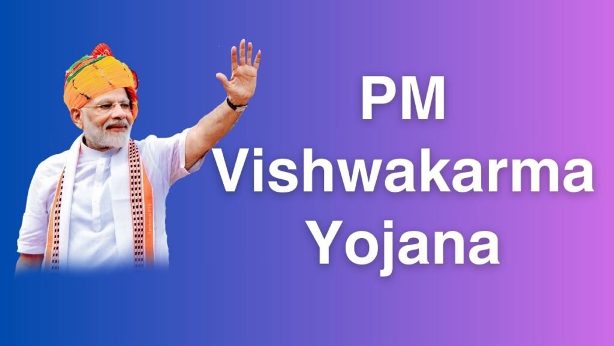Empowering India’s Artisans: PM VishwakarmaYojana
PM Vishwakarma Yojana
The PM Vishwakarma Yojana is dedicated to support traditional arts and crafts by providing multi-dimensional support to artisans. The initiative acknowledges the challenges faced by the sector due to modernization and market changes.The full name of PM Vishwakarma Yojana is “PM Vishwakarma Kaushal Samman Yojana”. It is also known by the other name i. e “PM Vishwakarma Yojana”. The PM Vishwakarma Yojana is launched on the occasion of the Vishwakarma Jayanti i.e. on 17-08-2023.
What is PM Vishwakarma Yojana
It is an initiative that operates as a Central sector Scheme and the scheme has been granted a substantial financial allocation of Rs 13,000 crore. The designated timeframe for its implementation spans five years, encompassing Financial Year 2023-24 through FY 2027-28. Under this scheme the artisans and the craftspeople will be provided recognition through a PM Vishwakarma certificate and ID Card, credit support up to Rs 1 lakh (First Tranche) and Rs 2 lakh (Second Tranche) with a concessional interest rate of 5%.
PM Vishwakarma Yojana 2023 objectives
The primary goal of the PM Vishwakarma yojana is to fortify and foster the time-honoured Guru Shishya parampara, a lineage-basedtradition where artisans and craftsmen adeptly ply their traditional skills using handcrafted techniques and tools. Additionally, the Vishwakarma scheme endeavours to enhance both the calibre and accessibility of products and services originating from these skilled artisans, while also facilitating the seamless integration of Vishwakarma practitioners into both local and international value chains.
Features of the PM Vishwakarma Yojana
- Recognition and support – Artisans and craftsman who are enrolled in the program will be receiving a PM Vishwakarma certificate and an identity card. They will also be eligible for a collateral free -credit support with the first tranche being up to Rs 1.0 Lakh and the second tranche up to Rs 2.0 Lakh, both at a concessional rate of interest of 5%.
- Skill development and empowerment- The Vishwakarma yojana is allotted a budget of Rs 13,000 cr to 15,000 cr over a period of five years from 2023-24 to 2027-2028.The scheme offers a stipend of Rs 500 for skill training and Rs 1,500 for the purchase of modern tools.
- Scope and coverage- The scheme covers 18 traditional trades, spanning both rural and urban areas. These trades include carpenters, boat makers, potters, blacksmiths,sculptors, cobblers, tailors and many more.
- Registration and implementation – Artisans can register for the Vishwakarma yojana at common service centres in villages. While the central government provides funding for the scheme, it also seeks support from state governments.
- Integration with value chains- A key objective of the program is to seamlessly integrate artisans in both domestic and global value chains. This integration aims to enhance their market access and opportunities for growth.
PM Vishwakarma Yojana Benefits
The following benefits will be provided to all Artisans and Craftspeople under PM Vishwakarma Yojana
- Loans up to Rs 1,00,000 will be provided at 5% interest rate in first phase.
- Loans up to Rs 2,00,000 will be provided at 10% interest rate in second phase.
- Skill training will also be provided.
- A stipend of Rs 500 will be provided during the training period.
- A Rs 15,000 will be provided to purchase advance tools
- PM Vishwakarma certificate and identity card will be provided.
PM Vishwakarma scheme components
- Financial assistance- Providing monetary support to artisans
- Enhanced skill development- Offering advanced training to elevatetheir expertise.
- Modern technological knowledge- Equipping artisans with contemporary digital techniques and eco-friendly technologies.
- Promotion of artisan brands- Boosting the visibility and recognition of artisans’ brands
- Market integration – connecting artisans with both local and global markets
- Digital payment facilitation – Promoting the adoption of digital payment methods.
- Social security measures – Ensure social security for artisans.
The PM Vishwakarma scheme with its substantial budget and noble objective has the potential to transform the prospects of India’s artisans. However, this triumph will be determined by its capacity not only to provide resources but to genuinely elevate the beneficiaries, ensuring they are prepared for the future and self-reliant. Achieving this shift demands meticulous planning, profound insight, and an unwavering commitment to well being of individuals.
Objectives of PM Vishwakarma yojana
- Promote and preserve traditional skills – The Vishwakarma yojana/scheme has several key objectives that address various aspects of artisan empowerment. Firstly, it seeks to create a favourable environment for artisans to practice their ancestral occupations and preserve traditional skills and craft heritage.
- It aims to enhance the income levels, productivity, quality and competitiveness of artisans by providing them with training, tools, credit support and exposure to new market.
- Thirdly the scheme facilitates access to formal credit for artisans through targeted financial assistance. It also focuses on upgrading their skills through training programmes and connecting them to domestic and international markets.
- Lastly the scheme provides social security in terms of insurance coverage for health, accidents and old age pensions.
Implementation Mechanism
The successful implementation of the Vishwakarma Yojana relies on establishing robust mechanisms for coordination, monitoring and grievance redressal at both the central and state levels. At the central level a nodal agency will be responsible for the overall coordination and policy framework. Collaboration between different central ministries and their field agencies will ensure relevant components and addressed.
The state level implementation will involve infrastructure and training institutes, livelihood missions and local NGOs to facilitate outreach and promotion.
Monitoring frameworks will track fund disbursements, targets, beneficiary coverage and skill development metrics. Further Audits and evaluation will assess on-ground efficiency.
Grievance redressal mechanism through call centres, online portals and helplines will ensure timely resolution and accountability.
The participative implementation architecture involving all the stakeholders from national to local levels aims to drive last mile connectivity and delivery of the scheme objectives.
Significance and Expected Impact
The comprehensive design and substantial layouts of the Vishwakarma Yojana hold great socio-economic significance by preserving India’s traditional crafts and artisans’skills, sustaining traditional knowledge systems, boosting pride in ancestral occupations, enhancing artisans’ incomes, productivity and market opportunities.
This scheme is expected to have a significant impact on nearly 5 million artisan households, promoting inclusive growth and empowerment. By integrating marginalized craft communities with main stream economies both nationally and globally through access to credit, skills and markets, it will enhance the competitiveness and export potential or artisan products.
Conclusion
Extensive awareness campaigns utilising various media platforms will be necessary to inform and mobilize beneficiaries nationwide. Strengthening last mile connectivity can be achieved through extensive outreach at grassroot level,facilitated by the agencies and the self-help groups. Furthermore, robust data collection on artisan communities using digital tools such as mobile apps and centralized dashboards will help in enhancing planning and monitoring efforts. Ensuring competitiveness of crafts against man made product will require maintaining quality benchmarks and providing the right product orientation. The scheme multidimensional approach, focussing on skills, access to credit, market, technology and social security for traditional artisans in India, holds great potential in uplifting marginalized communities and preserving heritage crafts.
However, meticulous on ground implementation and collaboration between government agencies, private sector and community organization are crucial for its success. Further robust monitoring and grievance systems will be imperative in delivering optimal outcomes.


